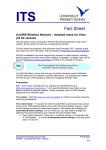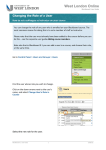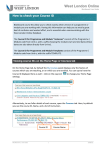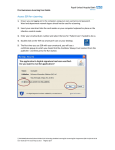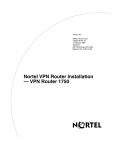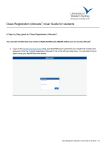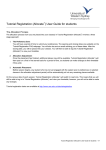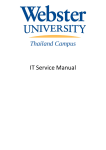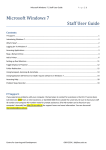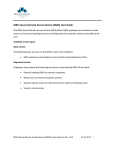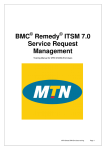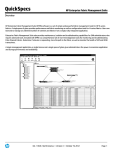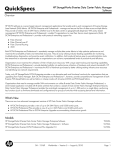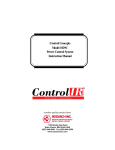Download Preparation:
Transcript
This fact sheet covers connecting to AirUWS with Microsoft Windows 7 (32 bit version). 64 bit versions of Windows 7 do not work with AirUWS. Note: Although AirUWS should work with Windows 7, there are known issues. Support from the University is limited to best effort. Note that the newer network AirUWS-Lite is recommended for most users. This fact sheet was prepared using Windows 7 Enterprise and Internet Explorer. Updates to this fact sheet will be available at http://www.uws.edu.au/wireless. AirUWS is available at no extra charge at key locations on each campus, including teaching spaces and other areas where students congregate. Coverage maps can be found at http://www.uws.edu.au/ wireless. AirUWS is not available off campus. Your use of AirUWS is subject to the University’s IT Acceptable Use of Resources Policy. You’ll find that there is more than one way to achieve the same result in Windows. This fact sheet does not attempt to address alternatives. It is assumed that readers will have a basic understanding of using and navigating Windows 7. Preparation: You – If you haven’t already done so, activate your MyUWSAccount at https://myuwsaccount.uws.edu. au/. You’ll need administrative user rights on your laptop to install the required software. Your laptop – Visit http://www.uws.edu.au/wireless to confirm your laptop meets the minimum specifications. Your web browser – To access the internet via AirUWS, your browser must use our proxy server. UWS standard laptops come with the correct settings; however, users of other laptops will need to ensure their browser’s LAN settings are configured to automatically detect settings. For non-UWS use, you may need to change this setting to that recommended by your Internet Services Provider (ISP). • Open Internet Explorer’s (IE) Tools menu à Internet Options à Connections tab à LAN settings… à ensure Automatically detect settings is the only option ticked à click OK. Updated:14/09/2011 Updated: 14/09/2011 1 IE 8’s proxy settings (IE 7 is almost identical) Reusing browser windows when launching a shortcut (eg, clicking a link in email) means you may accidentally move away from the AirUWS portal page and be disconnected. To change this setting: • Open IE’s Tools menu à Internet Options à Advanced tab à scroll to Browser settings à untick Reuse windows for launching shortcuts à click OK. You’ll also need to turn off your browser’s pop-up blocker, or ensure that pop-ups from *.uws.edu. au are allowed. • Open IE’s Tools menu à Pop-up Blocker à Click Turn Off Pop-up Blocker To reverse this action for non-UWS web access: • Open IE’s Tools menu à Pop-up Blocker à Click Turn On Pop-up Blocker Turn off Pop-up Blocker Updated:14/09/2011 2 Make certain Reuse windows for launching shortcuts isn’t ticked Some users may find that Internet Explorer won’t start with the AirUWS login screen. This may happen if you have a blank home page, a complex home page address, or your home page is stored in the browser’s cache. If you experience problems opening the login screen, try holding down your Shift key while pressing the F5 key. This action overrides the cache, and the login screen should open. If that fails, try setting your home page to http://www.uws.edu.au, which redirects properly. If AirUWS’ login page opens, there is no need to make changes. Changing your home page back for non-UWS use is optional. • Open IE’s Tools menu à Internet options à General tab à Home page à enter the new home page details à click OK. Updated:14/09/2011 3 Set your home page here Updated:14/09/2011 4 Connecting: Ensure your wireless hardware is turned on. Refer to your laptop’s user manual. To connect your laptop to AirUWS, locate the wireless icon in Windows 7’s system tray (next to the clock on the lower right). When the icon is selected, the Connect to Networks menu appears. The next window displays available wireless networks. You may find more than one wireless network available – select AirUWS and press Connect. Choose Connect Anyway when the unsecured network warning appears. Select AirUWS and click Connect Choose Connect Anyway Wait for the process to show you’re connected. This should take under 30 seconds. Updated:14/09/2011 5 Your hardware is now connected Your hardware is connected. Click Close before logging in. You may now be asked to Set Network Location for AirUWS, which automatically sets Windows firewall settings. Public is the most secure option, but staff machines will not be able to connect to network drives. Staff machines are able to connect to mapped network drives if Work is selected as the location. Network settings can be changed at a later date. Select a network location Updated:14/09/2011 6 Authenticate (log in) Open Internet Explorer. You should be automatically redirected to the login screen, where you’ll enter your MyUWSAccount login details. See the earlier comments under Preparation, Web Browser if you are not redirected to the login screen. The AirUWS login screen After logging in, Internet Explorer will download and launch TunnelGuard, which checks your laptop meets the minimum specifications. If TunnelGuard doesn’t start, you probably need to install Java Runtime Environment (JRE) Version 6, update 14 or later - use a networked computer to visit http:// www.java.com and download the software to a USB drive for installation on your computer. Known Java issue IT staff have discovered an issue with Java update 18. Changes to improve security made in this release cause a warning that “The publisher cannot be verified by a trusted source”. Although a button to dismiss the warning is provided, the warning stays on the screen, and you will not be able to login to AirUWS. Changing these settings is a security risk! Reverse changes when not using AirUWS Workaround: To get past this problem, you will need to make changes to your Java and Internet Explorer settings. These changes could be considered a security risk, and should be reversed when you use your computer outside of AirUWS. Updated:14/09/2011 7 Java: Open Windows Control Panel. Double click the Java icon to open the Java Control Panel. Choose the Advanced tab, and expand Security. Untick any option related to certificate validation and revocation. Untick any option related to certificate validation and revocation. Internet Explorer: From Internet Explorer’s Tools menu, choose Internet Options à Advanced tab. Scroll down to the Security section. Untick any option related to certificate validation and revocation. After making these changes, restart your machine. TunnelGuard should now work when you attempt to connect to AirUWS.If TunnelGuard finds your laptop doesn’t comply with the minimum specifications, it stops the connection process. Updated:14/09/2011 8 TunnelGuard checks your laptop If your laptop complies, the portal window opens and NetDirect (Nortel’s Virtual Private Network (VPN) software) will automatically download and run. You must install this software to use AirUWS. Choose Install when the Windows Security window appears. If you tick the box Always trust software from Nortel Networks, this message should not appear next time you connect to AirUWS. However, you should be aware that “always trusting” is a potential security risk. Choose Install After installation, the AirUWS portal will open. Updated:14/09/2011 9 The AirUWS portal screen – don’t close this window! You’ll also see a banner message welcoming you to the campus Wireless Gateway. You must wait for this message before going further (it may take a minute or so). Press OK. Now you’re fully connected to AirUWS. Note: If you don’t see the banner message, you haven’t connected – close Internet Explorer and start the authentication process again. Click OK on the welcome message. A Nortel NetDirect icon and bubble notification will also appear in your system tray For security reasons, each time you connect you’ll go through the authentication, download and installation process. Updated:14/09/2011 10 I’m connected – what can I do? Don’t close the AirUWS portal window, or you’ll be disconnected. Open a new browser window or tab to surf the web. This allows you to keep the portal window running while using the web. Web based programs such as Internet Explorer and MSN Messenger should work normally. As in the ITS computer labs, all users of AirUWS are required to re-authenticate when they try accessing external websites. Enter your MyUWSAccount details in the login box, and press OK. You may be asked to authenticate more than once. uthenticate with your MyUWSAccount details Note: UWS recommends using your ISP’s web portal to access your home email account. UWS Save your work before logging off! cannot provide any assistance with access to non UWS email. Privately owned computers are not able to connect to network shares, synchronise off-line files or print, but will have internet access. If you need to print from a privately owned laptop, we recommend saving your work to a USB drive, which you can take to an on campus computer lab to print as you normally do in the labs. Updated:14/09/2011 11 How do I log off? Users of UWS standard computers should save their work, manually synchronise their files, close open programs (other than the AirUWS portal page), and use the logoff link on the portal page. Users of privately owned computers should save their work, close open programs (other than the AirUWS portal page), and use the logoff link on the portal page. Log off using the Logout link on the portal page Help In the first instance, students should contact the IT Support Officers located at each campus’ ITS computer labs. Students can also contact the ITS Service Desk for phone based support. Staff should contact the ITS Service Desk. Tips: Save often. Wireless networks are inherently less reliable than wired networks, and you could lose your data if your network connection is lost. Save often to minimise the risk of losing data. In most Windows applications, simultaneously pressing the ctrl and s keys saves the current document Don’t try and connect wirelessly while still running a wired connection – the laptop may get confused about which connection to use. You may need to grant exemptions in your firewall product to allow TunnelGuard and NetDirect to work. Updating your laptop’s wireless drivers may give a more reliable and consistent service, however, the appearance of your network connection may change. Inactivity timeouts apply. UWS has a limited number of licences available for wireless connection. To be fair and allow others to connect, users are automatically logged off after a lengthy period of inactivity. Updated:14/09/2011 12 Known Issues: Java issue Details on pages 7 and 8 of this document. Windows 7 may fail compliance tests, even with an accepted Antivirus product. Windows 7 comes with a security feature called User Account Control (UAC). When UAC is turned on, TunnelGuard is unable to detect your Antivirus product, so compliance fails. A work around is to turn UAC off, but doing so is against Microsoft’s recommendations. To turn off User Account Control, open the Control Panel à open User Accounts and Family Safety à open User Accounts à click Change User Account Control à drag the sliding scale down to Never Notify. Restart your computer. Turning off Windows 7’s User Account Control is a security risk! Reverse changes when not using AirUWS. Move the scale to the original position and restart to turn UAC back on when you stop using AirUWS. Open User Accounts Change User Account Control Settings Updated:14/09/2011 13 Restart your computer to apply the changes If you are still unable to connect to airUWS, try connecting to AirUWS-Lite instead. AirUWS-Lite is the University’s newest wireless network, and is easier to use and compatible with more systems than AirUWS. More information: More information is available at http://www.uws.edu.au/wireless. IT Service Desk Phone: 02 9852 5111 (ext 5111) Email: itservicedesk@uws.edu.au Web: http://www.uws.edu.au/itservicedesk Self Service job logging: http://itsm.uws.edu.au UWS IT Services Catalogue: http://www.uws.edu.au/its ITS Fact Sheets http://www.uws.edu.au/itfactsheets Updated:14/09/2011 14














